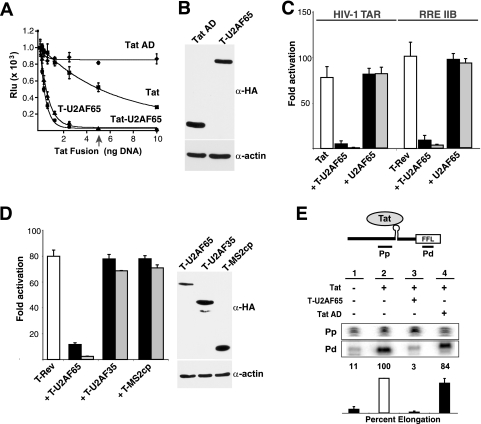FIG. 2.
Tat RNA-binding activity is dispensable for transcription elongation inhibition. α, anti. (A) Dose-response curves indicating inhibition of T-BIV-mediated activation on an HIV-1 LTR-BTAR-FFL reporter by the Tat AD, Tat, T-U2AF65, and Tat-U2AF65 (Table 2). The arrow indicates the position corresponding to stoichiometric DNA concentrations (5 ng) of inhibitor and activator. (B) HeLa cells were cotransfected with HA-tagged versions of the Tat AD and T-U2AF65, and total cell extracts were probed for expression levels with anti-HA antibody or with antiactin to control for protein loading. (C) Activation by HIV-1 Tat and T-Rev (Tat AD fused to Rev) (Table 2) measured in the absence (white bars) or presence (black bars) of T-U2AF65 or unfused U2AF65 by using the HIV-1 LTR-FFL and HIV-1 LTR-RREIIB-FFL reporters indicated. Black bars are 1:0.2 and gray bars are 1:1 ratios of activator to T-U2AF65 or unfused U2AF65. (D) The left panel shows results for activity of T-Rev (white bar) or T-Rev cotransfected with T-U2AF65, T-U2AF35, or T-MS2cp at 1:0.2 (black bars) and 1:1 (gray bars) ratios of T-Rev activator to T-fusion by using the HIV-1 LTR-RREIIB-FFL reporter. The right panel shows results for expression of the T-fusions in nuclear extracts, probed with anti-HA or antiactin to control for protein loading. (E) T-U2AF65 blocks transcription elongation. Cells were transfected with HIV-1 Tat, the Tat AD, or T-U2AF65 as indicated, and RNase protection was performed with a Pp probe directed to the HIV-1 LTR and a Pd probe directed to the FFL open reading frame to quantify transcription rates. The experiment was performed in duplicate with similar results.

